Heptagram
| Regular heptagram (7/2) | |
|---|---|
 A regular heptagram | |
| Type | Regular star polygon |
| Edges and vertices | 7 |
| Schläfli symbol | {7/2} |
| Coxeter diagram |
|
| Symmetry group | Dihedral (D7) |
| Internal angle (degrees) | ≈77.143° |
| Dual polygon | self |
| Properties | star, cyclic, equilateral, isogonal, isotoxal |
| Regular heptagram (7/3) | |
|---|---|
 A regular heptagram | |
| Type | Regular star polygon |
| Edges and vertices | 7 |
| Schläfli symbol | {7/3} |
| Coxeter diagram |
|
| Symmetry group | Dihedral (D7) |
| Internal angle (degrees) | ≈25.714° |
| Dual polygon | self |
| Properties | star, cyclic, equilateral, isogonal, isotoxal |
A heptagram, septagram, or septegram is a seven-point star drawn with seven straight strokes.
The name heptagram combines a numeral prefix, hepta-, with the Greek suffix -gram. The -gram suffix derives from γραμμῆς (grammēs) meaning a line.[1]
Geometry
In general, a heptagram is any self-intersecting heptagon (7-sided polygon).
There are two regular heptagrams, labeled as {7/2} and {7/3}, with the second number representing the vertex interval step from a regular heptagon, {7/1}.
This is the smallest star polygon that can be drawn in two forms, as irreducible fractions. The two heptagrams are sometimes called the heptagram (for {7/2}) and the great heptagram (for {7/3}).
The previous one, the regular hexagram {6/2}, is a compound of two triangles. The smallest star polygon is the {5/2} pentagram.
The next one is the {8/3} octagram, followed by the regular enneagram, which also has two forms: {9/2} and {9/4}, as well as one compound of three triangles {9/3}.
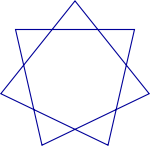 {7/2} |
 {7/3} |
 {7}+{7/2}+{7/3} |
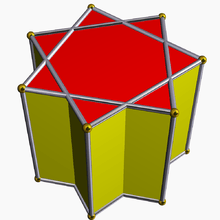 7-2 prism |
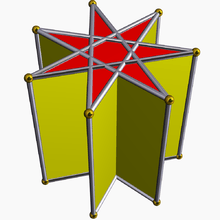 7-3 prism |
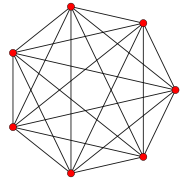 Complete graph |
 7-2 antiprism |
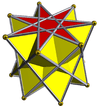 7-3 antiprism |
 7-4 antiprism |
In popular culture
-

Former Georgian coat of arms, 1918–1921, 1991–2004
-

Roundel of the Georgian Air Force
-

Flag of Cherokee Nation
-
.svg.png)
The seven-pointed star of the Felibritge on the Occitan flag.
-

The Jordanian flag, bearing the star that symbolizes Al-Fatiha
-

Logo of Maersk
-

Symbol of Hokkaido
Religious and occult symbolism
- The heptagram was used in Christianity to symbolize the seven days of creation and became a traditional symbol for warding off evil.
- The heptagram is a symbol of perfection (or God) in many Christian sects.
- The heptagram is used in the symbol for Babalon in Thelema.
- The heptagram is known among neopagans as the Elven Star or Fairy Star. It is treated as a sacred symbol in various modern pagan and witchcraft traditions. Blue Star Wicca also uses the symbol, where it is referred to as a septegram. The second heptagram is a symbol of magical power in some pagan religions.
- The {7/3} heptagram is used by some members of the otherkin subculture as an identifier.
- In alchemy, a seven-sided star can refer to the seven planets which were known to ancient alchemists.
Flags
- The seven-pointed star is incorporated into the flags of the various bands of the Cherokee Nation and the badges of Navajo Nation Police (as well as other police).
- The Flag of Jordan contains a seven-pointed star.
- The Flag of Australia employs five heptagrams and one pentagram to depict the Southern Cross constellation and the Commonwealth Star.
- Some old versions of the coat of arms of Georgia (country) including the Georgian Soviet Socialist Republic used the {7/2} heptagram as an element.
Other
- A seven pointed star is used as the badge in many sheriff's departments and some smaller-community police departments.
- The seven pointed star is used as the logo for the international Danish shipping company A.P. Moller–Maersk Group, sometimes known simply as Maersk.
See also
References
Bibliography
- Grünbaum, B. and G.C. Shephard; Tilings and Patterns, New York: W. H. Freeman & Co., (1987), ISBN 0-7167-1193-1.
- Grünbaum, B.; Polyhedra with Hollow Faces, Proc of NATO-ASI Conference on Polytopes ... etc. (Toronto 1993), ed T. Bisztriczky et al., Kluwer Academic (1994) pp. 43–70.
- John H. Conway, Heidi Burgiel, Chaim Goodman-Strass, The Symmetries of Things 2008, ISBN 978-1-56881-220-5 (Chapter 26. pp. 404: Regular star-polytopes Dimension 2)